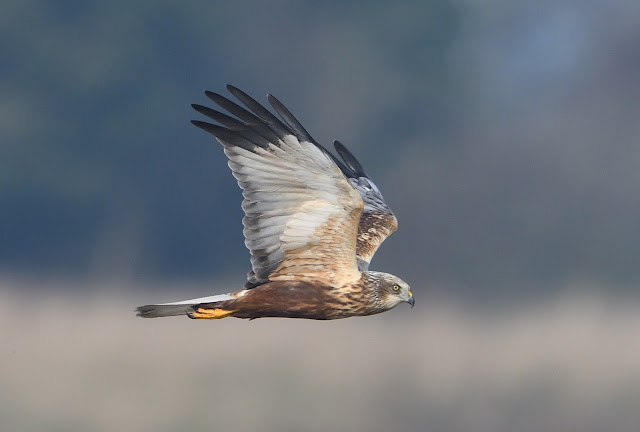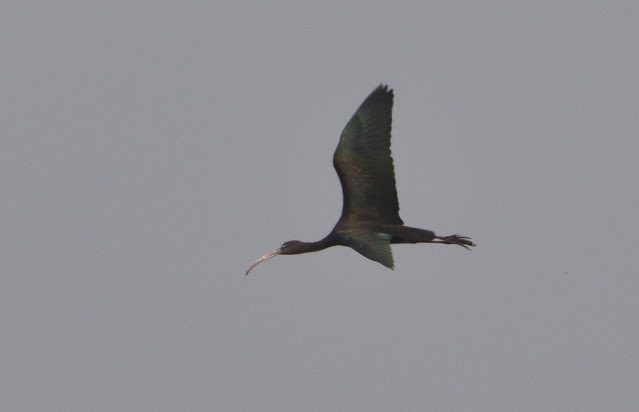 |
| a Male Marsh Harrier searching for breakfast. |
After two years of lockdown, the time has come to start our travels again. We have not visited the UK since March in 2020, so the opportunity to visit one of my favourite Nature Reserves was always going to be high on my itinery.
The forecast was good, but cold for the 24th March, so at 05.00 and at a temperature of just 1 degree, I arrived at Stodmarsh just before sunrise. It was a 'still' day with barely a breath of wind and all that could be heard, was the 'murmering' of water fowl awakening from their slumber.
 |
| A cold and misty start to the day as the sun came up, with frost still on the ground. |
As the sun started to rise, so did some of the birds and whilst there was not really enough light for photographing birds in flight, I stopped down the camera to f4 and kept the shutter speed as low as possible. These images are therefore rather 'noisy', but at least capture the day as it unfolded and the light slowly improved.
There were a lot of Swans roosting on the first lake and I wanted to wait for them to fly off, before walking up to the first hide. I was hoping that they might fly towards me, but they clearly had other ideas and exited stage right, before banking away to the left! They would spend their day raiding the farmers crops a few miles away, prior to returning to roost, later in the evening.
 |
| I love the light coming in from the rising sun, which really picks up the golden colours of the reed beds. |
It was now time to move on and the first 'hide' (David Feast Hide) was just a few hundred meters along the path. Fortunately, this hide is perfectly positioned to give the light behind us and whilst still very early (06.00), the light was now good enough to increase the shutter speed and 'depth of field'. The hides at Stodmarsh are a good size and very close to the waterways that run between the reed beds. It was not long before I was joined by some other early risers who entered the hide with their cameras, binoculars and scopes. After a few whispered discussions about what birds were in the area, an atmosphere of calm and silence ensued. So, in an environment similar to a public library (one word or cough, and a bout of 'shushing' would erupt), it was time to get down to business and photograph some birds.
 |
| Incoming Lapwing. |
 |
| Male Shoveler Duck. |
 |
| Female Shoveler Duck. |
 |
| Finally, a Swan flew towards me. |
 |
| This Lapwing clearly showing its colourful plumage. |
 |
| a pair of Gadwall. |
 |
| a pair of Shovelers. |
 |
| Mediterranean Gull. |
 |
| This female Pochard, is a rare visitor. |
 |
| Coots are the delinquents of the marshes and are forever chasing each other! |
 |
| Incoming Shelduck. |
 |
| Female Gadwall. |
Of course, as well as the Water Fowl, Stodmarsh is renowned for its Marsh Harriers and this year, there were a reported 5 nesting pairs! The largest of the harriers, the marsh harrier can be recognised by its long tail and light flight with wings held in a shallow 'V'. It is distinguishable from other harriers by its larger size, heavier build, broader wings and absence of white on the rump. Females are larger than males and have obvious creamy heads. Although 5 pairs are believed to be present, that fact does not gaurantee a sighting, let alone a photographic opportunity, so I was relieved to be able to get the following shots.
 |
| I could watch these birds all day.........sadly, I only had 3 sightings all day long! |
It was now time to move on to the 'Marsh Hide', which is a twenty minute walk further into the marshes. This has recently been renewed and is a triple aspect hide, which gives great views and can accept up to 6 people (although there were at least 10 whilst I was there). I had been told that a rare 'Glossy Ibis' had been spotted from this hide recently, so was very pleased to find that it was still in-situ when I arrived. Sadly, it was a L O N G way off and even with the 700mm lens, it was a push to get acceptable images. However, a 'rough' image of this bird, was better than no image at all. - I waited for 3 hrs, but it was not going to come any closer!
 |
| Not my best work, but just too far away! |
Those 3 hours, hoping that the Ibis might venture closer, at least gave gave me the opportunity to get some interesting images of the other birds that were coming and going. Needless to say, there was a steady stream of bird watchers arriving in the hide and due to the squeeky hinges on the door, I was kept entertained by the continuous 'shushing' sounds, coming from the serious 'twitchers' every time that someone moved, or opened the door. As I often tell people, i'm just a photographer.........if I need to find out what I have photographed, I simply look it up on 'google'.
 |
| a pair of Greylag Geese coming in. |
 |
| another Greylag Goose on a low level approach. |
.JPG) |
| Two shots above of this Male Gadwall in full flight. |
 |
| Graylag Goose in nice pose. |
 |
| Common Heron. |
 |
| Male Shoveler. |
 |
| a pair of Grey Heron taking off. |
 |
| Lapwing. |
 |
| a Reed Bunting. |
 |
| a juvenile Cormorant skimming the surface. |
 |
| an incoming Gadwall. |
 |
| a Reed Warbler. |
 |
| Reed Warbler - Male |
 |
| Bearded Tit. |
My day at Stodmarsh Nature Reserve came to an end and although there are many birds that I did not see, it's always good to have a reason to return. Hopefully, I will get that opportunity next week, before we leave Kent and head for Scotland. We will be staying on the 'Lanrick Estate' near Stirling, where I hope to stalk some Red Deer.
In the meantime, I hope that you have enjoyed this blog and will return for the next adventure!
If you enjoy my blogs, please share them on facebook etc.
Older blogs can be viewed by clicking on the ☰ symbol, at the top of the home page.






















.JPG)































Amazing clarity you get with your shots
ReplyDeleteAs always, an amazing set of photos, I love the Lapwing, and there are some incredible refection shots here. The coot 'running' on the water is fabulous, but my favourite has to be the Marsh Harrier, birds of prey are very special to me.
ReplyDeleteSound like you are having a good time. À bientôt, Diane